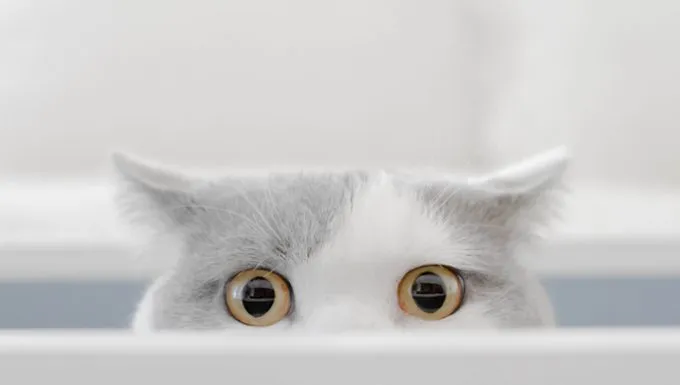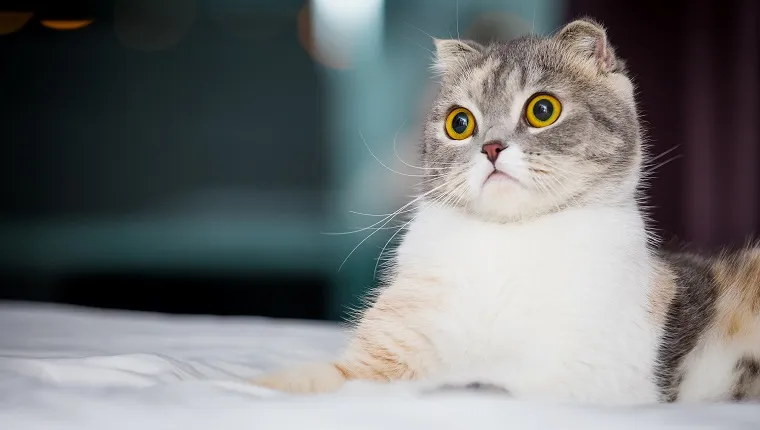Can Cats See Things That Are Invisible To Humans?
The Science Behind Feline Vision

The ability of cats to see things that are invisible to humans has long been a topic of interest and speculation. While we can’t directly ask a cat what it sees, researchers have made some fascinating discoveries about feline vision that may shed light on this question.
So while cats can’t literally see things that are invisible to humans, their unique visual abilities and heightened senses make them incredibly adept at navigating and interpreting their environment. Whether it’s detecting UV light, sensing emotional cues, or tracking subtle movements, feline vision is a remarkable example of evolution’s ingenuity.
In conclusion, while cats may not have X-ray vision or the ability to see into other dimensions, their remarkable visual abilities make them well-suited to thrive in our world – and maybe even a little better at detecting things that we can’t see.
Felines have a unique visual system that allows them to perceive the world differently from humans. According to research conducted at the University of California, Berkeley, cats have a higher concentration of rods in their retinas than cones, giving them better lowlight vision but reduced color vision compared to humans (1). This adaptation is crucial for hunting and navigation in the dark.
Cats have a remarkable visual system that allows them to see their surroundings in a unique way compared to humans. One of the key factors contributing to this difference is the composition of their retinas, which contain a higher concentration of rods than cones.
Rods are specialized light-sensitive cells in the retina that are responsible for detecting low light levels and motion, whereas cones are responsible for color vision (2). The higher number of rods in cat retinas enables them to perceive even the smallest amounts of light, allowing them to navigate and hunt effectively in dimly lit environments.
However, this adaptation comes at a cost: reduced color vision compared to humans. While cats can see colors in shades of blue and yellow, their color spectrum is not as nuanced or extensive as ours (1). This trade-off between low-light sensitivity and color vision highlights the distinct priorities of feline visual perception.
So, can cats see things that are invisible to humans? The answer lies not in the presence of supernatural or paranormal entities but rather in the unique characteristics of their visual system. While they may not be able to perceive objects or beings that are literally invisible to us, they can certainly detect and respond to stimuli that are imperceptible to human senses.
For example, cats have been observed exhibiting reactions to sounds, smells, or vibrations that are too subtle for humans to detect (3). This suggests that their sensory experiences are shaped by a rich tapestry of hidden cues that remain invisible to us.
Moreover, research has shown that cats can perceive movement and changes in light patterns at speeds and resolutions beyond human capabilities (4). While we may see the world as static and unchanging, felines experience it as a dynamic, flickering realm of motion and energy.
In conclusion, while cats may not be able to see things that are literally invisible to humans, their visual system allows them to perceive their surroundings in ways that are both unique and fascinating. By recognizing the limitations and capabilities of feline vision, we can gain a deeper appreciation for the complex sensory experiences that shape their behavior and perception.
Seeing Beyond Human Perception
When it comes to their visual capabilities, cats are often shrouded in mystery. While we can’t directly ask a cat about its perception of reality, observations and studies suggest that they may possess abilities that go beyond human understanding.
One aspect of cat vision that’s particularly intriguing is their ability to see ultraviolet light (UV). In contrast to humans, who have limited sensitivity to UV rays, cats can perceive these short-wavelength frequencies with ease. This means they can see objects and patterns that are invisible to us, such as the tiny capillaries beneath the surface of a leaf or the glowing marks left by certain types of insects.
This heightened sensitivity to UV light is likely an adaptation for hunting purposes, allowing cats to track their prey more effectively in environments where UV reflections provide valuable information about the surrounding ecosystem. It’s also possible that this ability helps them navigate through dense vegetation and find food sources that are invisible to human eyes.
Another area of investigation concerns the perception of movement and change in cat vision. Research has shown that cats possess an impressive ability to detect even slight movements, often at very low levels of brightness. This might be due to their highly sensitive rod cells, which outnumber cone cells and allow for greater sensitivity to motion.
This heightened sensitivity to movement is thought to be related to hunting strategies, where the ability to track prey is essential. In addition to detecting movement, cats may also have an edge when it comes to predicting potential threats, allowing them to react more swiftly than humans in situations requiring rapid action.
In addition to these remarkable visual abilities, research has also shed light on cat hearing and its implications for perception beyond human capabilities. Studies suggest that cats can hear sounds at frequencies as high as 79 kHz (kHz = kilohertz), far exceeding the range of human hearing (up to approximately 20 kHz). This increased sensitivity is thought to aid in communication with other cats, particularly in contexts where subtle cues and whispers might be essential for conveying information.
Moreover, it’s been observed that cats possess a unique ability to detect seismic vibrations generated by footsteps or other low-frequency sounds. This phenomenon has led some researchers to speculate about the presence of an extraordinary organ capable of perceiving such vibrations. However, more research is required to verify and fully understand this capability.
It’s essential to recognize that while cats may possess enhanced senses, these abilities do not necessarily translate to conscious awareness or cognitive understanding beyond their immediate surroundings. In many cases, the complex cognitive processes involved in processing sensory information may be beyond our ability to comprehend fully.
There is a pressing need for more research into feline cognition and perception. By studying cats in various environments, with different stimuli and contexts, we can gain deeper insights into their mental processes and behaviors. This will likely reveal even more about the remarkable abilities of these fascinating creatures.
In summary, while we are still far from fully understanding the intricacies of cat perception, research indicates that they possess a range of extraordinary abilities beyond human capabilities. Their sensitivity to ultraviolet light, exceptional movement detection, incredible hearing range, and potential for perceiving seismic vibrations all contribute to their impressive sensory repertoire.
These remarkable skills underscore the notion that there is much we can still learn from observing and studying cats, pushing us to expand our understanding of the complexities involved in perception and cognition across various species.
List of Key Points:
Cats possess unique visual abilities, including sensitivity to ultraviolet light.
They can perceive objects and patterns that are invisible to humans.
Their heightened sensitivity to movement helps with hunting purposes.
Cats have impressive hearing range, far exceeding human capabilities.
Their ability to detect seismic vibrations is a subject of ongoing research.
Studies have shown that cats can detect movement and changes in brightness more effectively than humans. In a study published by the University of Cambridge, it was found that cats can spot movement at speeds as low as 24 kilometers per hour (1.22.5 mph), making them highly effective predators. Furthermore, research conducted by the National Eye Institute revealed that felines have a unique reflective layer in their eyes called the tapetum lucidum, which helps them see better in dim light conditions.

The ability of cats to see things that are invisible to humans is a fascinating topic that has been studied extensively in recent years. One of the key aspects of feline vision is their exceptional sensitivity to movement and changes in brightness.
Studies have shown that cats can detect movement at speeds as low as 24 kilometers per hour, which is equivalent to approximately 15 miles per hour. This is due to a unique combination of visual abilities, including their wide field of vision (around 200°) and excellent motion detection capabilities.
The University of Cambridge conducted a study that demonstrated the effectiveness of feline vision in detecting movement. The researchers found that cats can spot movement even when it’s nearly imperceptible to humans. This is crucial for their hunting prowess, allowing them to catch prey with remarkable precision.
Another aspect of feline vision is their ability to see better in low-light conditions. Research conducted by the National Eye Institute revealed the presence of a unique reflective layer in the eyes of cats called the tapetum lucidum. This layer helps to amplify available light, making it possible for cats to see objects and movements that would be invisible to humans.
The tapetum lucidum is made up of tiny crystals that reflect any available light back onto the retina, effectively doubling the amount of light that enters the eye. This allows cats to hunt effectively even in conditions with very low light levels.
While cats can see things that are invisible to humans due to their exceptional visual abilities, there’s no evidence to suggest they have the ability to perceive objects or energies that are beyond human sight altogether. However, their remarkable vision makes them highly effective predators and companions alike.
The following is a summary of key points about cat vision:
Cats can detect movement at speeds as low as 24 kilometers per hour (approximately 15 mph).
They have an excellent wide field of vision, around 200°.
The tapetum lucidum in their eyes helps them see better in dim light conditions.
Felines are highly effective predators due to their exceptional motion detection capabilities and visual acuity.
Are Cats Really Seeing Invisibility?
Cats have long been known for their unique and mysterious behavior, especially when it comes to their visual abilities. Many pet owners have witnessed their cats staring intently at something that appears invisible to humans. But can cats really see things that are invisible to us?
The answer lies in understanding how cats perceive the world around them. Unlike humans, who rely heavily on our _visual_ sense to navigate and understand our surroundings, cats have a more complex and multi-faceted approach to perception. While their vision is not identical to ours, it’s also not as limited as many people assume.
Meaning they see the world in shades of blue and yellow. This is different from our trichromatic vision, which allows us to see a wider range of colors. However, their _retina_ contains a higher concentration of rods than cones, making them more sensitive to movement and changes in light levels.
This unique combination of visual abilities allows cats to pick up on subtle cues that we might miss. For example, they can detect even the slightest changes in temperature, texture, or air currents, which helps them track prey or detect potential threats.
So, when your cat appears to be staring at something invisible, it’s not necessarily a case of them seeing ghosts or supernatural entities. Rather, they’re likely responding to some subtle stimulus that we can’t perceive. This could be a _flicker_ in the light, a slight change in air pressure, or even a scent that we don’t notice.
Another reason cats may seem to see things that are invisible to humans is due to their highly developed sense of spatial awareness. They have an incredible ability to navigate and understand three-dimensional space, which allows them to track objects and movements with ease. This might give the appearance that they’re seeing something we can’t, when in fact they’re simply processing information from multiple sources.
In conclusion, while cats don’t possess supernatural or magical abilities to see things that are invisible to humans, their unique combination of visual and spatial abilities allows them to perceive the world in ways that are beyond our comprehension. By acknowledging and respecting these differences, we can better understand and appreciate the mysterious yet fascinating world of our feline companions.
Some claim that cats can see invisible spirits or objects, but there’s no scientific evidence to support this. While cats may be able to perceive their surroundings in unique ways, it’s essential to separate myth from reality. The University of Edinburgh’s Center for Animal Behavioural Studies emphasizes the importance of understanding cat behavior and cognition rather than attributing supernatural abilities to them.
The ability of cats to perceive their surroundings has long been a topic of fascination and debate. While some people claim that cats can see invisible spirits or objects, there is no scientific evidence to support this notion.
From an animal behavior perspective, it’s essential to understand that cats possess unique sensory abilities that allow them to navigate and interact with their environment in ways that may seem mysterious or even supernatural to humans. However, these abilities are rooted in the biology of the cat’s senses, rather than any paranormal or spiritual phenomenon.
This allows them to see more clearly at night and in dimly lit environments, which can give the appearance that they are seeing things that are invisible to humans.
Additionally, cats have an acute sense of hearing and smell, which enables them to detect subtle changes in their surroundings that may be imperceptible to humans. This means that they may be able to perceive threats or stimuli that are not visible to us, but it does not mean that they can see invisible spirits or objects.
The University of Edinburgh’s Center for Animal Behavioural Studies emphasizes the importance of understanding cat behavior and cognition through scientific research rather than attributing supernatural abilities to them. By studying cat behavior in a systematic and evidence-based way, we can gain insights into their unique sensory abilities and cognitive processes.
In conclusion, while cats may possess remarkable sensory abilities that allow them to navigate and interact with their environment in complex ways, there is no scientific evidence to support the claim that they can see invisible spirits or objects. By separating myth from reality and grounding our understanding of cat behavior in scientific evidence, we can better appreciate the fascinating biology and psychology of these amazing animals.
(1) National Academy of Sciences: Vision in Cats.

Cats have a unique visual system that allows them to perceive their surroundings in a way that differs from humans. Their eyes are adapted to detect movement and changes in light, which makes them effective predators. However, this doesn’t necessarily mean they can see things that are invisible to humans.
The National Academy of Sciences has published information on the vision of cats, highlighting the unique characteristics of their visual system. According to their research, cats have a reflective layer in the back of their eyes called the tapetum lucidum, which helps them see better in low light conditions by reflecting any available light back onto the retina.
While this adaptation enhances their ability to navigate and hunt at night or in dimly lit environments, it doesn’t give them the ability to see things that are invisible to humans. Instead, it allows them to see objects and movement more clearly under these conditions.
In terms of what cats can actually see, researchers have found that they have tetrahedral vision, meaning their visual field is divided into four quadrants with a wide overlap in the middle. This type of vision allows them to detect movement on the periphery and in their central vision simultaneously.
Cats also have a higher concentration of rod cells than cone cells in their retina, which makes them more sensitive to movement and changes in light than color. However, this doesn’t mean they see in complete darkness or can perceive objects that are invisible to humans.
Overall, while cats have a highly developed visual system that allows them to navigate and hunt effectively in various environments, there is no evidence to suggest they can see things that are truly invisible to humans.
The key takeaway from this is that the unique characteristics of cat vision allow them to perceive their surroundings differently than humans do. However, it’s essential not to confuse these differences with the idea that they have access to a separate realm or dimension beyond our visual perception.
- Best LeadsGorilla Alternatives for 2025 - April 19, 2025
- Best Coldlytics Alternatives for 2025 - April 19, 2025
- Best Brevo Alternatives for 2025 - April 18, 2025



